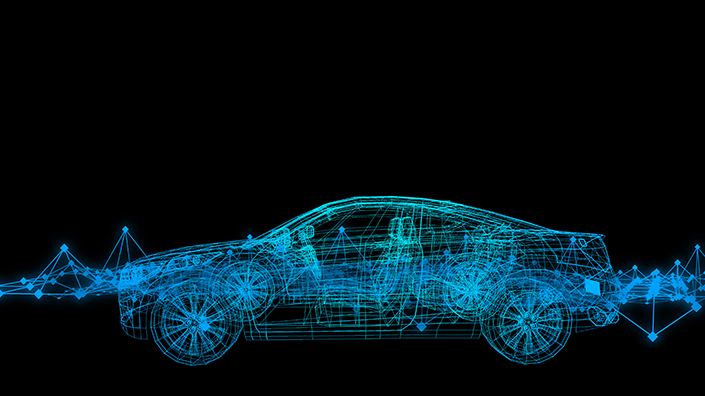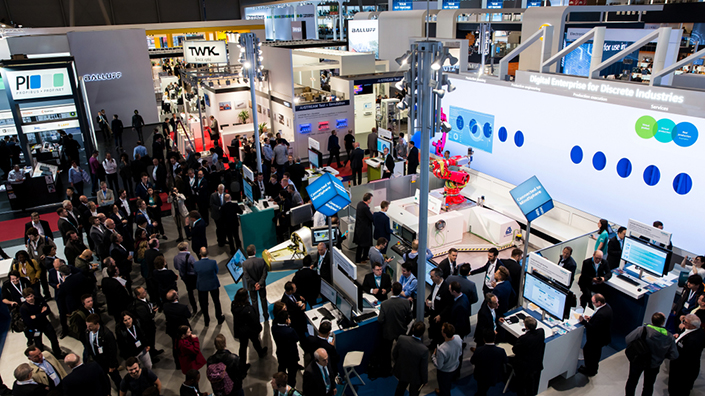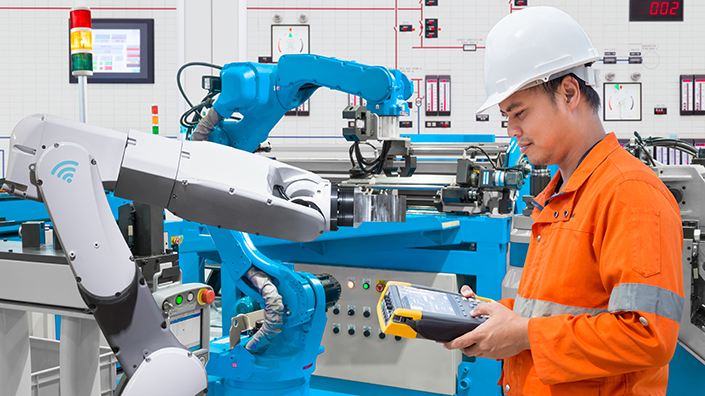There was a time when factory workers relied on their senses. A burning smell, unfamiliar vibrations or steam rising from a machine were all signs that something was about to go wrong, or had gone wrong already. But by then it would often be too late to merely carry out maintenance. It had become a repair job and, more often than not, an urgent one. Over time, factory workers’ experience would teach them to schedule maintenance at regular intervals, in the hope that this would prevent problems from occurring in the first place.
The world has moved on since then, however. Industry has embarked on a digital transformation that is changing every aspect of how it operates. At the heart of this transformation lies predictive maintenance.
“Predictive maintenance is one of the leading use cases for the industrial Internet of Things (IoT) and Industry 4.0,” according to IOT Analytics, which last year published a report on the US market. “The market for predictive maintenance applications is poised to grow from $2.2bn in 2017 to $10.9bn by 2022, a 39% annual growth rate,” says the company.
Although predictive maintenance is “still in its infancy,” or rather, “in the relatively early stages of true deployment,” it is fast becoming a standard part of all machines, equipment and assets for manufacturers and operators around the world, according to Accenture’s Ben Salama, who heads up the consultancy’s Industry X.0 practice in the UK and Ireland.
Industrial giants such as Siemens, GE, Bosch and ABB are at the forefront of the developments, along with software players such as IBM, SAP, Microsoft, Intel and Cisco, according to IOT Analytics’ ranking of predictive maintenance companies. Their efforts are enabling manufacturers and other operators to reduce their reliance on the nous of their workers to spot when things have gone wrong. Predictive maintenance is even allowing industry to move beyond scheduled maintenance as the main route to greater efficiency. Instead, companies rely on a myriad of sensors that monitor variables such as heat, vibration, light, sound and moisture.
Operators can use data from these sensors to create so-called ‘digital twins’ of machines, allowing them to identify faults before they appear. Sensors are used in a range of industries, from automotive to utilities, from chemicals to oil and gas, and from life sciences to industrial equipment manufacturers, says Salama.

(Credit: Shutterstock)
Indeed, sensors are not merely integral to modern assets, but can also be retrofitted to old machines, according to Robert Kowalik, vice-president of sales at Bluvision. The company’s sensors resemble memory sticks and cost about £25, and can be fitted on machines to take measurements. They are connected by Bluetooth to a receiver, which costs about £50 and resembles an electric plug, which in turn is connected to wi-fi. The system allows the data to be transferred into the cloud. Other companies, such as ABB and SSV Software Systems, offer similar solutions.
“The technology has reached a point where you can monitor old machines,” says Kowalik. “It’s almost free. Plug it in and it’ll be working. Set baseline, then measure in real time to a tenth of a second monitoring.
“You don’t send out staff, there’s no site work. This is the way things are going.”
The shift from reactive to predictive maintenance delivers a range of benefits. “It enables plant operators to do effective maintenance planning for their motors, assess the efficiency of their operation, and prevent costly downtime,” says Jonas Spoorendonk, global product manager of the ABB Ability Smart Sensor, which was on show at Hannover Messe in April. “This solution will not only transform maintenance approaches but also create added operational value for our customers.”

The Hannover Messe trade show (Credit: Shutterstock)
He adds: “In a typical example, a sensor at a chemical plant in Germany indicated that a pump motor was running in overload every time it started. The problem turned out to be the incorrect operation of a valve. This was causing high pressure in the system and a great deal of stress on the pump and seals – a situation that the plant’s regular maintenance had no way to detect.
“In many other cases, sensors have provided early warnings of bearing problems, enabling motors to be replaced well before they failed.”
The data that is gathered can add value in other ways too. “The data becomes the real currency and value here,” says Accenture’s Salama. But as sensors have become ubiquitous, generating ever more comprehensive data sets, industrial companies must go beyond mere condition monitoring and become more analytical in their approaches in order to harness such value. “They have to become software companies as well as industrial companies, and to do that they must broaden the skills and capabilities within their organisations,” says Salama. “This is actually tough. The transformation these companies have to go through is massive.”
Connected machines
Connectivity is central to this transformation. Take the Italian wood-cutting equipment manufacturer Biesse, which has gone through a “shift from a product-oriented to a service-oriented manufacturer,” according to general manager Stefano Porcellini. Biesse’s challenge was not data gathering. Sensors in its wood-cutting machines were already monitoring their condition and gathering operational data. But the data did not go anywhere. The only time the company knew about any problems was when its customers called to complain. Biesse would then have to send out a technician to download the relevant data to a laptop, before returning to base to analyse it.
By connecting the sensors to the internet, using an industrial Internet of Things platform, the company was able to implement realtime monitoring of all the machines it had supplied. In turn, the company’s business model changed. It now offers services such as remote diagnostics, warnings and alerts, as well as condition-based and predictive maintenance and usage analysis, says Porcellini. The insights the company has gained from its big data set mean it can also offer advice to customers about how to optimise their production processes.
Advances in analytics
Simply receiving a slew of data will not provide insight on its own. “The data gathering is not the complicated part,” says Salama. “The analytics, the algorithm creation, is where it gets complicated.”
Analytics algorithms help computers identify the best times to carry out maintenance to ensure it only happens when needed. With fewer maintenance windows, you also require fewer tool sets, and the downtime of the machines is reduced, says Thorsten Wujek, chief executive of IT-RSC UK, an IT services company headquartered in Lower Saxony, Germany. “The downtime of machines is very important for manufacturing companies,” he says. “There are a lot of cost pressures in mechanical engineering. You have to cut costs wherever you can.”
Big data analytics is not just looking to identify worn components that are due for replacement, however. “That’s condition monitoring,” says Wujek. “It’s from limits that are crossed, but it’s not learnt.” The operator or technician carrying out maintenance is in no position to “know all the correlations – our brains are not powerful enough,” he says. So to take full advantage of big data analytics, the machines must learn from their own experience, with the help of “deep-learning neural networks, which help us spot patterns in big data sets. The machine will learn over time, so it gets better and better.”

(Credit: Shutterstock)
Wujek explains: “The idea behind neural networks is, you don’t have to be an expert. In fact, you don’t want to be an expert, because if you are you’ll judge the data subjectively. When you don’t assume anything, that risk is not there. We just get all the data, and then we look for patterns. The only thing the system is searching for is correlation. There are no assumptions.”
McKinsey consultant Vasanth Ganesan, and partners Michael Chui and Mark Patel, say in their report Taking the Pulse of Enterprise IoT that “the combination of sensor data and sophisticated analytical algorithms has allowed companies to streamline processes, increase productivity, and develop leading-edge products”. The savings can be significant. The US rail company Union Pacific, for instance, achieves annual savings of $100m thanks to predictive maintenance.
Challenging transition
To traditional manufacturing, engineering and operating companies, this transition of skills and learning from human to machine is nevertheless confusing. “Businesses often struggle with data extraction, management and analysis,” according to the McKinsey report. “For instance, 70% of respondents stated that companies have not yet integrated IoT solutions into their existing business work flows – in other words, they are not using enterprise IoT to optimise day-to-day tasks.”
One reason is the sheer number of software solutions on the market. Accenture’s Salama says: “If you have multiple production lines in your factory, every equipment supplier will say they have the best IoT dashboards, offering all these services. The challenge for the operator, who is bombarded with multiple siloed systems, is to avoid a situation where they have a lot of different user interfaces, with dozens of screens in their chemical plant or on their oil rig. The challenge is to consolidate these siloed systems into a single decision-making tool.”
The transition is both appealing and appalling. It is appealing from a cost point of view, as there are clearly savings to be had. But it is also appalling because it seems to devalue the skills and experience of employees, who have hitherto been the main forces behind manufacturing and engineering progress.
“You want to get rid of the human factor, get rid of the human skill,” says Wujek, pointing out that a company’s reliance on skilled people leaves it vulnerable. “If experienced people with that ‘gut feeling’ leave to join a competitor, the intellectual property leaves with them. So we want to get that ‘gut feeling’ built into the system.” This does not mean people will become redundant, but the nature of work is likely to change, he says.
Harriet Green, general manager of Watson Internet of Things at IBM, agrees. “Cognitive abilities will enable us to sense and feel way beyond what current automation can,” she says, stressing that it is vital to combine human experience and cognitive computing intelligence. “Together, man and machine can go forward in a big way.”
Nevertheless, says Wujek, “it’s OK to be concerned, because nobody knows where we’re heading”.
Content published by Professional Engineering does not necessarily represent the views of the Institution of Mechanical Engineers.